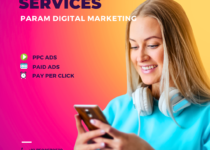How to Run Effective Online Advertising Campaigns
💡 Want to maximize your ad budget? Learn how to create, optimize, and measure successful online advertising campaigns.
Running online ads is one of the fastest ways to increase brand visibility, generate leads, and drive sales. But without a proper strategy, you could be wasting money on ineffective ads.
In this guide, you’ll learn the key steps to creating and optimizing online advertising campaigns that actually convert.
1. Understand the Different Types of Online Advertising
Not all ads work the same way. Choose the right ad platform based on your goals and audience.
🔹 Google Ads (Best for Search Intent & Local Businesses)
- Appears on Google search results.
- Ideal for high-intent buyers searching for specific products or services.
- Uses keywords and bidding strategies to rank higher.
📌 Example: If someone searches “best project management software”, your ad can appear at the top.
🔹 Facebook & Instagram Ads (Best for Social Engagement & E-Commerce)
- Great for brand awareness, lead generation, and direct sales.
- Uses detailed audience targeting based on interests, behaviors, and demographics.
- Supports image ads, carousel ads, and video ads.
📌 Example: A business selling digital planners can target entrepreneurs and students on Instagram.
🔹 TikTok Ads (Best for Viral Growth & Younger Audiences)
- Best for brands targeting Gen Z and Millennials.
- Works well with short, engaging video ads.
- Lower cost-per-click (CPC) compared to other platforms.
📌 Example: A fitness brand can run “30-day challenge” video ads to engage users.
🔹 LinkedIn Ads (Best for B2B & Professionals)
- Perfect for business-to-business (B2B) marketing.
- High-quality audience, but higher cost-per-click.
- Great for recruiting, consulting, and SaaS companies.
📌 Example: A company selling SEO tools can target marketing professionals on LinkedIn.
2. Define Your Campaign Goal
Before creating an ad, be clear on your objective. Different goals require different strategies.
🔹 Brand Awareness → Reach as many people as possible.
🔹 Lead Generation → Collect emails or contact information.
🔹 Website Traffic → Drive visitors to your landing page.
🔹 Sales & Conversions → Sell digital products, courses, or services.
📌 Example: If you’re launching a new ebook, use lead generation ads to capture emails before selling.
3. Target the Right Audience
A successful ad campaign targets the right people at the right time. Use these targeting options:
✅ Demographics — Age, gender, location, education level.
✅ Interests & Behaviors — Hobbies, online activity, purchase history.
✅ Custom Audiences — People who have interacted with your business.
✅ Lookalike Audiences — New users similar to your existing customers.
📌 Example: If you’re selling marketing templates, target freelancers, small business owners, and social media managers.
4. Create High-Converting Ad Content
Your ad must grab attention and make users take action. Use these elements:
✅ Strong Hook — Capture interest in the first 3 seconds.
✅ Clear Message — Keep the text short and impactful.
✅ Call to Action (CTA) — Tell users what to do next (Buy Now, Sign Up, Learn More).
✅ Engaging Visuals — Use high-quality images or videos.
📌 Example: Instead of saying “Buy our course”, try:
🚀 “Want to master social media? Get our step-by-step course today!”
5. Optimize Your Landing Page for Conversions
Your ads should lead to a high-converting landing page. Ensure it includes:
✔️ A Clear Headline — Reinforce your ad message.
✔️ Short & Persuasive Copy — Explain benefits, not just features.
✔️ Trust Signals — Testimonials, reviews, and security badges.
✔️ Fast Load Speed — Pages that load in under 3 seconds convert better.
📌 Example: If your ad promotes a digital product, the landing page should have a “Buy Now” button above the fold.
6. Set a Realistic Budget and Bidding Strategy
Your budget determines how many people see your ads. Use these bidding strategies:
💰 Cost-Per-Click (CPC) — Pay when someone clicks your ad. Best for driving website traffic.
💰 Cost-Per-Mille (CPM) — Pay per 1,000 impressions. Best for brand awareness.
💰 Cost-Per-Acquisition (CPA) — Pay when someone converts (buys, signs up). Best for sales-focused ads.
📌 Example: If your goal is email sign-ups, use a lead generation ad with a CPA bidding strategy.
7. Test, Analyze, and Improve Your Ads
The best marketers test different versions of their ads to see what works best. Use A/B Testing to compare:
📊 Headlines & Copy — Which text converts better?
📊 Images vs. Videos — Do people engage more with video?
📊 Call to Actions — Does “Get Started” perform better than “Sign Up Now”?
Use tools like Facebook Ads Manager, Google Ads Analytics, and TikTok Ads Dashboard to track:
✅ Click-Through Rate (CTR) — Are people clicking your ad?
✅ Cost-Per-Click (CPC) — Are you spending efficiently?
✅ Conversion Rate — Are users taking action after clicking?
📌 Example: If one ad gets 50% more conversions, increase its budget and pause the underperforming one.
Final Thoughts 💬
Online advertising is a powerful tool, but success comes from testing, refining, and targeting the right audience. Follow these steps to create campaigns that generate leads, drive sales, and grow your business.


